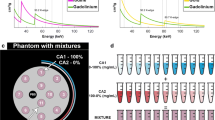Abstract
We have measured the X-ray fluorescence from gadolinium as a function of concentration and position in tumors of different sizes and shapes in a head phantom. The gadolinium fluorescence was excited with a 36 GBq Am-241 source. The fluorescence signal was detected with a CdTe detector and a multi-channel analyzer. The fluorescence peak was clearly separated from the scattered X-rays. Concentrations of 5.62–78.63 mg/ml of Gd ion were used in 1, 2, and 3 cm diameter spherical tumors and a 2 × 4 cm oblate spheroid tumor. The data show trends approaching saturation for the highest concentrations, probably due to reabsorption in the tumor. A comparison of X-ray photographic imaging and densitometer measurements to determine concentration is also presented.







Similar content being viewed by others
References
Shih JL, Brugger RM (1992) Gadolinium as a neutron capture therapy agent. Med Phys 19(3):733–744
Harms AA, Norman GR (1972) The role of internal conversion electrons in gadolinium-exposure neutron imaging. J Appl Phys 43(7):3209–3212
Weinmann HJ, Brasch RC, Press WR, Wesbey GE (1984) Characteristics of gadolinium-DTPA complex: a potential NMR contrast agent. Am J Roentgenol 142:619–624
Allen BJ, McGregor BJ, Martin RF (1989) Neutron capture therapy with gadolinium-157. Strahlenther onkol 165:156–157
Miller GA, Hertel NE, Wehring BW, Hornton JL (1993) Gadolinium neutron capture therapy. Nucl Technol 103:320–331
Ichikawa H, Watanabe T, Tokumitsu H, Fukumori Y (2007) Formulation considerations of gadolinium lipid nanoemulsion for intravenous delivery to tumors in neutron-capture therapy. Curr Drug Deliv 4(2):131–140
Carlsson J, Forssell-Aronsson E, Glimelius B (2002) Radiation therapy through activation of stable nuclides. Acta Oncological 41(7–8):629–634
Klykov SA, Ul’yanenko SE, Matusevich ES, Kurachenko YuA, Dulin VA (2004) Tissue absorbed dose from a gadolinium layer irradiated with neutrons. At Energy 96(6):430–433
Brugger RM, Shih JA (1989) Evaluation of Gadolinium-57 as a neutron capture therapy agent. Strahlenther onkol 165(2–3):153–156
Yoshida K, Furuse M, Kaneoke Y, Saso K, Inao S, Motegi Y, Ichihara K, Izawa A (1989) Assessment of T1 time course changes and tissue blood ratios after Gd-DTPA administration in brain tumors. Magn Reson Imaging 7(1):9–15
Bartolini ME, Pekar J, Chettle DR, McNeill F, Scott A, Sykes J, Prato FS, Moran GR (2003) An investigation of the toxicity of gadolinium based MRI contrast agents using neutron activation analysis. Magn Reson Imaging 21(5):541–544
Shih JL, Brugger RM (1992) Gadolinium as a neutron capture therapy agent. In: Allen BJ, Moore DE, Harrington BV (eds) Progress in neutron capture therapy for cancer. Plenum Press, New York, pp 183–186
Shapero J (1981) Radiation protection. A guide for scientists and physicians, 2nd edn. Harvard University Press, Cambridge, p 232
Haar PJ, Broaddus WC, Chen ZJ, Fatouros PP, Gillies GT, Corwin FD (2010) Gd-DTPA T1 relaxivity in brain tissue obtained by convection-enhanced delivery, magnetic resonance imagine and emission spectroscopy. Phys Med Biol pp 3451–3465
Author information
Authors and Affiliations
Corresponding author
Rights and permissions
About this article
Cite this article
Almalki, M., Majid, S.A., Butler, P.H. et al. Gadolinium concentration analysis in brain phantom by X-ray fluorescence. Australas Phys Eng Sci Med 33, 185–191 (2010). https://doi.org/10.1007/s13246-010-0020-x
Received:
Accepted:
Published:
Issue Date:
DOI: https://doi.org/10.1007/s13246-010-0020-x




